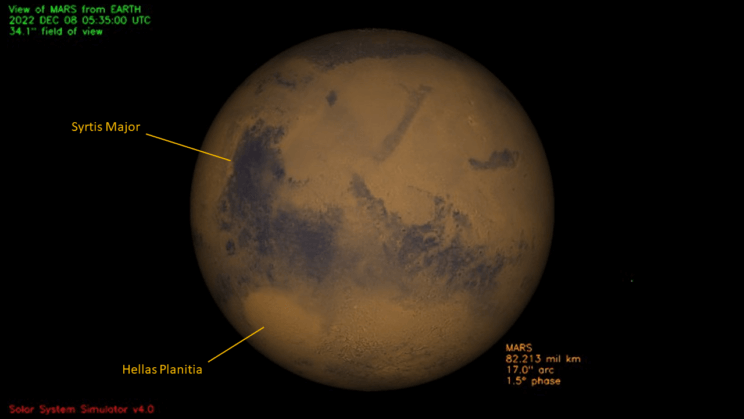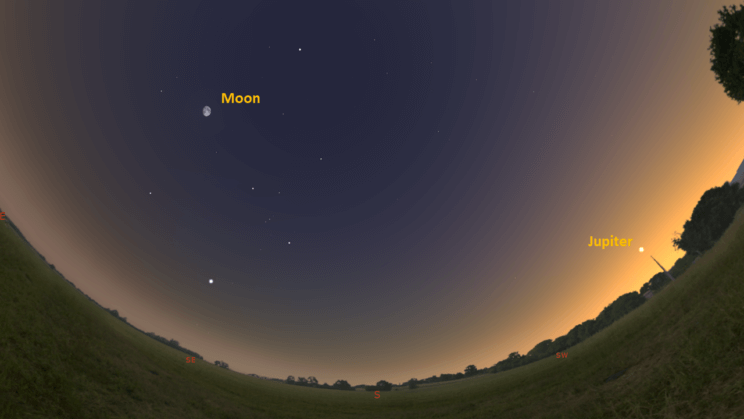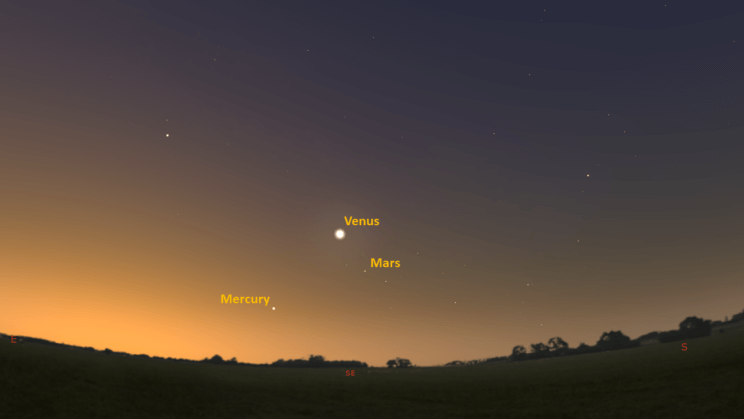This is the Saint Louis Science Center’s NIGHT SKY UPDATE for the week of Friday, February 11, 2022.
Information updated weekly or as needed.
Times given as local St. Louis time which is Central Standard Time (CST). For definitions of terminology used in the night sky update, click the highlighted text. If relying on times posted in Universal Time (UT), St. louis is -6 hours when CST.
Public Telescope Viewings
With the changing recommendations from the CDC regarding COVID-19, conversations regarding the return of star parties at the Saint Louis Science Center have begun. We are close to bringing back our public telescope viewings, but a few details still need to be worked out. We will post future updates as we learn more about when we can bring back telescope viewings.
Observing Highlight of the Week

Mars seen on December 7, 2022, when at opposition. The image shows more detail that what we will see in a telescope but it does highlight the features that will be visible such as Syrtis Major and Hellas Planitia. Image credit NASA Solar System Simulator v4.0.
Late last year, Mars started a new apparition. As the year progresses, Mars offers several interesting things to see. Mars at opposition, several conjunctions and an occultation are events we can look forward to seeing this year.
At the start of 2022, Mars is visible in the early morning. By the end of August, Mars will rise around midnight and by September, Mars will finally rise in evening hours. In addition to rising earlier each month, Mars will also increase in brightness. Right now, Mars shines with an apparent magnitude of 1.7. By August it will be 0.0 and in December, -1.9 when at opposition. This increase is caused by Earth getting closer to Mars in our orbit.
This year several interesting observing events involve Mars. To start things off, the Moon passes by Mars each month. This is because the Sun, Moon and planets are all seen in the same path represented by the zodiac constellations. Each month the date of these pairings change because the Moon’s synodic cycle is 29.5 days long and Mars is moving. The Moon Mars pairings occur on Feb. 27, Mar. 28, Apr. 26, May 24/25, June 22, July 21, Aug. 19, Sept. 17, Oct. 15, Nov. 11 and Dec. 7. Of special note, February, August and December are the best months to see the Moon and Mars together because the first two will be conjunctions, and in December, the Moon will occult Mars.
Periodically, the planets also appear near one another in the sky during a conjunction or appulse. These terms describe very similar events, but they are not the same thing. A conjunction is when two or more astronomical bodies share the same right ascension. An appulse is when two or more astronomical bodes appear close in the sky. Visually, these are very similar events, but conjunctions are specific to the object’s coordinates and an appulse is when they are closest. Often the specific moment of a conjunction or appulse occurs before the objects are visible from your location. Even if the exact moment of these events does not line up with when you can see them, you will see similar conditions. Observing these events are a great way to learn about the planets and how our solar system functions. A conjunction or appulse will often involve the Moon or naked eye planets. Due to this, these are great events for beginning star gazers.
Mars will reach conjunction with several planets this year. The moment of these conjunctions occurs during the day but each of these dates will offer us a nice close pairing of planets. First, on February 27, 2022, the Moon, Venus and Mars will be seen together before sunrise. This morning both Venus and Mars will be in conjunction with the Moon. Around 6:00 a.m. all three will be seen rising in a near vertical line. On March 12, 2022, Venus and Mars will reach conjunction. You will see the pair rising by 6:00 a.m. in the southeast just before they reach conjunction. On April 4, 2022, Saturn and Mars will reach conjunction and exhibit an appulse. Unfortunately, both events occur after they have set for the day. Regardless, Mars and Saturn will be seen close together becoming visible by 5:30 a.m. in the southeast. Lastly, Mars and Jupiter will reach conjunction on May 28, 2022, and the following morning they will exhibit an appulse. You will find them rising in the east around 3:20 a.m.
Observing all the events above is a great way to track the motion of Mars. The term planet means wanderer. This description is based on how our ancestors noted that the planets move independently of the background stars. Like the Moon, the planets motions carry them through the path of zodiac constellations. In 2022, Mars will move through the zodiac constellations from Sagittarius in January to Taurus in December.
When tracking the motion of a planet, we are watching how they move with respect to the Sun. This is the elongation of a planet. Because Mars is farther from the Sun, it is considered a superior planet. Being superior Mars can appear on the opposite side of the Sun, a point called superior or solar conjunction. Mars can also appear near the anti-solar point which is opposite the Sun. This is called opposition which occurs for Mars on a period of 26 months. Mars reaches opposition on December 7, 2022. A few days earlier on December 1, 2022, Earth and Mars will be their closest for this apparition. Between these dates is when Mars will be seen at its best.
As we approach opposition, the surface of Mars becomes visible through backyard telescopes. If using telescopes with apertures of 4-inches and up, surface features should be visible as early as May 11, 2022. What we see is the contrast between light and dark areas. The first features you will likely see are the ice caps. Depending on the Martian season it could be both or just one. Other notable features are Syrtis Major and Hellas Planitia. There are nuances to observing details on the Martian surface. Weather conditions on Earth and Mars can impact what we see. Additionally, certain color filters used on an eye piece can enhance certain surface features. If you would like to learn more about this, visit https://alpo-astronomy.org/mars/articles/FILTERS1.HTM.
Lastly, on the night of Opposition, Mars will pass behind the Moon for close to an hour. This is called an occultation. Occultations occur as one object passes in from of another obscuring it from view. Each month, the Moon occults many faint stars, but a few times each year, the Moon will occult a planet or bright star. The IOTA lists the occultation starting at 9:05 p.m. in St. Louis and ending at 9:54 p.m. on December 7, 2022. There will likely be a little variance in time depending on your location, so I recommend start observing at least 30 minutes prior to the event. It will be visible naked eye, but I recommend using binoculars or a telescope.
The Sun and Moon

The Moon as seen from the International Space Station, on July 31, 2011.
Credit: NASA
Sunrise is at 6:56 a.m. on Friday, February 11 and sunset is at 5:34 p.m. providing us with roughly 10.5 hours of daylight. Even after sunset, the light from the Sun will dimly illuminate our sky for roughly 1 hour and 30 minutes. This period is called twilight, which ends around 7:04 p.m. this week. For those with a sundial, local noon occurs around 12:16 a.m. this week.
| Day | Sunrise | Sunset |
|---|---|---|
| 2022-02-11 | 6:56 a.m. | 5:34 p.m. |
| 2022-02-12 | 6:55 a.m. | 5:35 p.m. |
| 2022-02-13 | 6:54 a.m. | 5:36 p.m. |
| 2022-02-14 | 6:53 a.m. | 5:38 p.m. |
| 2022-02-15 | 6:51 a.m. | 5:39 p.m. |
| 2022-02-16 | 6:50 a.m. | 5:40 p.m. |
| 2022-02-17 | 6:49 a.m. | 5:41 p.m. |
| 2022-02-18 | 6:48 a.m. | 5:42 p.m. |
| 2022-02-19 | 6:46 a.m. | 5:43 p.m. |
Moon
Moonrise for Friday, February 11 occurs at 12:53 p.m. and moonset will occur at 4:29 a.m. on the following day. On Friday, February 11 the Moon will exhibit a waxing gibbous phase with 78% of the lunar disk illuminated. Full moon occurs on February 16, 2022, at 10:57 a.m.
International Space Station (ISS) Observing

Visible passes of ISS from St. Louis for the week of February 11 occur during Morning hours. The best passes this week occur on February 17 and 19. Use the table below for information about these and other visible passes this week.
Catch ISS from St. Louis starting Friday, February 11
| 15 Feb | -0.6 | 06:14:39 | 10 | SSE | 06:16:40 | 15 | SE | 06:18:39 | 10 | E |
|---|---|---|---|---|---|---|---|---|---|---|
| 17 Feb | -2.6 | 06:13:29 | 10 | SSW | 06:16:42 | 45 | SE | 06:19:55 | 10 | ENE |
| 18 Feb | -1.6 | 05:25:45 | 10 | S | 05:28:34 | 25 | SE | 05:31:22 | 10 | ENE |
| 19 Feb | -1.0 | 04:39:35 | 13 | SSE | 04:40:28 | 14 | SE | 04:42:19 | 10 | E |
| 19 Feb | -3.6 | 06:13:34 | 10 | WSW | 06:16:53 | 56 | NW | 06:20:11 | 10 | NE |
Magnitude (Mag): The Measure of brightness for a celestial object. The lower the value is, the brighter the object will be.
Altitude (Alt): The angle of a celestial object measured upwards from the observer’s horizon.
Azimuth (Az): The direction of a celestial object, measured clockwise from an observer’s location with north being 0°, east being 90°, south being 180° and west being 270°.
For information about ISS flyovers and other visible satellites, visit www.heavens-above.com
Detailed information regarding all unmanned exploration of our universe, missions past, present, and planned, can be found at Jet Propulsion Laboratories:
The Visible Planets

Looking southwest, at 6:00 p.m. February 12, 2022. Credit: Stellarium, EG

Looking southeast, at 6:25 am, February 13, 2022. Credit: Stellarium, EG
This week, four naked eye planets are visible. Jupiter is visible in the southwest after sunset. Mercury, Venus and Mars are seen in the southeast before sunrise.
Mercury
Mercury is currently exhibiting a morning apparition. About 30 min before sunrise Mercury will be found about 8° above the southeastern horizon. Mercury will reach greatest western elongation on February 16, 2022. This week will be our best chance to find Mercury before the Sun rises.
Venus
Venus has started a morning apparition and as such will be seen in the southeast before sunrise. Venus can be found rising by 4:25 and should be easy to spot in the southeast by 5:00 a.m. This morning apparition lasts until the third week of October 2022. Venus reaches superior conjunction on October 22, 2022.
Mars
A new apparition for Mars has begun. Mars rises at 4:50 a.m. Start looking for Mars around 5:30a.m. as it clears trees and buildings. Mars will continue to climb out of the Sun’s glare as it heads towards opposition later this year on December 7, 2022.
Jupiter
Look for Jupiter in the southwest as it starts to darken outside. Jupiter sets at 6:47 p.m. and will set about 20 minutes earlier each week. Jupiter reaches superior conjunction on March 5, 2022.
James S. McDonnell Planetarium
Night Sky Update: February 11 – February 19, 2022






